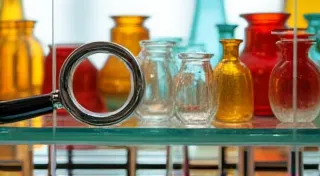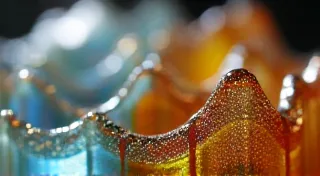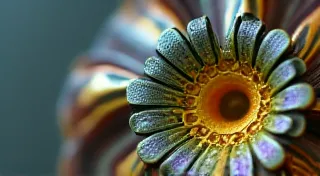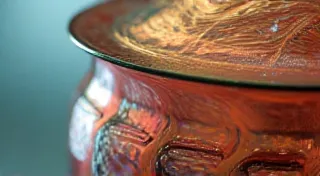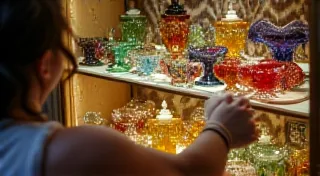The Art of Carnival Glass Slag: Its Formation and Beauty
Carnival glass is beloved by collectors for its vibrant colors, intricate patterns, and shimmering iridescence. While the overall effect is captivating, a key ingredient contributing to its unique appeal is slag glass. But what *is* slag glass, and how does it make its way into these beautiful pieces?
Understanding Slag Glass
Simply put, slag glass is a type of glass made from waste materials from other glassmaking processes. Historically, glass factories produced a range of colored glass. The leftover “skimmings” – often containing metal oxides – were essentially waste. Instead of discarding these materials, clever glassmakers repurposed them. The exact composition varied depending on the metals present. Iron produced a reddish-brown, copper created greens and blues, and manganese resulted in purples and violets. These “slag” remnants were then incorporated into new glass batches.
Initially, slag glass was often used as a cheaper alternative to colored glass, filling in areas to reduce material costs. But as glassmakers began to appreciate its aesthetic qualities, slag glass was deliberately introduced to enhance the visual appeal of glass pieces. For those new to the world of Carnival glass, understanding these nuances is key, and a beginner's guide to Carnival glass can be a fantastic starting point to grasp the fundamentals.

The Manufacturing Process – Integrating Slag
The integration of slag glass into carnival glass wasn’t a simple mix-and-pour process. There were different methods employed, each impacting the final appearance of the piece. Several approaches existed:
- Layering: Slag glass could be layered directly onto a clear glass base. This technique often resulted in pronounced, distinct patterns.
- Marbling: Small amounts of slag glass were carefully marbled into a clear glass batch, creating a more subtle, swirling effect. This is perhaps the most common technique.
- Mixing: Sometimes, slag glass was simply mixed into the molten clear glass. This often resulted in a more mottled and less defined pattern compared to marbling.
The temperature and timing were critical. The slag glass had to be introduced at the right moment during the glassblowing or pressing process to ensure proper integration without completely dissolving. The uneven distribution of metals within the slag glass itself also contributed to the unpredictable and unique patterns found on each piece. This variability often creates a treasure hunt for collectors seeking unique finds – something that can be explored further with the resources available to Carnival glass collectors, as detailed in the best resources for Carnival glass collectors.
The Beauty of the Effect
The appearance of slag glass in carnival glass isn't uniform. It manifests in a variety of ways:
- Mottling: Patches of darker, uneven color – often reddish-brown or greenish.
- Swirls: Fluid, swirling patterns that resemble flowing water or abstract artwork.
- Flecks: Small, scattered spots of color.
- Streaks: Distinct lines or bands of color.
The complexity and unpredictability of the slag glass’s appearance is what makes each carnival glass piece unique. Collectors prize the variety of patterns and the way light interacts with these inclusions. The effect is often described as having a “painterly” quality – as if an artist had brushed the colors directly onto the glass. Knowing what to look for and avoiding common pitfalls, especially for those just starting out, is crucial. This is why understanding common mistakes Carnival glass collectors make and knowing how to avoid them can be so beneficial; those lessons can be found in common mistakes Carnival glass collectors make (and how to avoid them).

Identifying Slag Glass
While slag glass is a hallmark of carnival glass, it’s important to note that not all carnival glass contains slag. Pieces described as "blank" or "clear" do not have this inclusion. When examining a piece, look for areas of mottled or swirled color that aren't part of the overall pattern. These are the telltale signs of slag glass. Remember, the appearance is highly variable, so familiarity with a wide range of examples is key to accurate identification. Sometimes, the best examples showcase incredibly rare color combinations, like those found in "Peachblow" Carnival glass. Spotlight on 'Peachblow' Carnival glass will give a deeper understanding of this sought-after variation, exploring its history, characteristics and value.

Deeper Dive: The Chemistry and Manufacturing Challenges
Beyond the visual appeal, understanding the chemical intricacies of slag glass production reveals a fascinating story of resourcefulness and innovation. The specific colors produced by slag glass are directly tied to the metals present in the waste glass. Iron, as mentioned, typically yields reddish-brown hues. Copper introduces greens and blues, while manganese contributes to purples and violets. The challenge for glassmakers wasn't just incorporating these metals; it was controlling their distribution to create the desired visual effect. Different temperatures and mixing techniques would significantly alter the final appearance. A higher temperature, for example, might cause metals to dissolve more completely, leading to a more uniform color. Conversely, lower temperatures could result in larger, more distinct inclusions. The unpredictability of these processes is part of what makes each piece of carnival glass so unique. Furthermore, the quality of the waste glass itself played a crucial role. Variations in the composition of the "skimmings" could lead to unexpected color shifts and patterns, demanding constant adjustments by the glassmakers. The art of working with slag glass was truly a blend of science and artistry.
The Evolution of Slag Glass Use in Carnival Glass
Initially, the inclusion of slag glass was largely driven by economic necessity. Factories were looking for ways to reduce production costs, and incorporating waste materials was a logical solution. However, as glassmakers experimented with different techniques, they began to realize the aesthetic potential of slag glass. They started to intentionally incorporate it into their designs, using it to create specific visual effects. This shift marked a significant evolution in carnival glass production, moving beyond mere cost-saving to a deliberate artistic choice. Early examples often showcased more subtle slag inclusions, often mimicking natural phenomena like sunsets or flowing water. Later pieces, as techniques improved and artistic intent grew stronger, saw bolder, more decorative patterns emerge, incorporating complex swirls and streaks. The understanding of this evolution can greatly enhance a collector’s appreciation of the art form, and guides them on a path of discovery.
The Science Behind the Colors: A Closer Look
Let’s delve a bit deeper into the chemistry. The color produced by slag glass is intrinsically linked to the metallic oxides present. Iron, the most common impurity, frequently contributes to the warm reddish-brown hues that characterize many examples. The oxidation state of the iron plays a vital role – iron(II) compounds tend to produce green colors, while iron(III) compounds result in brown or reddish-brown shades. Copper, on the other hand, is responsible for the vibrant greens and blues we occasionally see. The amount of copper present and its interaction with other elements in the glass matrix heavily influences the final color. Manganese compounds typically introduce purple or violet tones, although these can sometimes appear more subtle depending on the glass composition. It’s also worth noting that the presence of multiple metal oxides can lead to complex color interactions, resulting in unique and unexpected shades. Glassmakers often had limited control over these interactions, adding to the unpredictable nature of slag glass.
Beyond the Basics: Rare Slag Combinations and Their Value
While standard slag combinations are relatively common, truly rare color combinations are highly prized by collectors. For instance, pieces displaying a distinctive combination of copper and manganese, resulting in a vibrant blue-purple hue, command premium prices. Similarly, examples exhibiting a complex interplay of iron and copper, producing a mesmerizing blend of green and brown, are exceptionally valuable. The scarcity of these rare color combinations, combined with their stunning visual appeal, makes them highly sought-after by serious collectors. Understanding these subtleties isn’t just about appreciating the beauty – it's also crucial for accurate identification and valuation. The more a collector knows about the factors that influence slag coloration, the better equipped they are to assess the rarity and value of a piece. To help navigate the nuances of Carnival glass collecting and valuation, consider exploring in-depth guides and expert opinions – many are available to those eager to expand their knowledge.
Conclusion
The inclusion of slag glass is a vital component of carnival glass's charm and character. Understanding its origins, manufacturing process, and the visual effects it creates deepens the appreciation for these stunning, collectible pieces. The ingenuity of glassmakers who transformed waste into beauty is a testament to their skill and creativity, and a major reason why carnival glass continues to fascinate collectors worldwide. Careful observation and a little bit of research can go a long way in appreciating and identifying these unique pieces of art.
